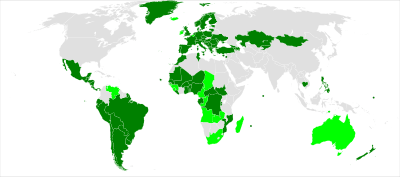Optional Protocol to the Convention against Torture
| Optional Protocol to the Convention against Torture and Other Cruel, Inhuman or Degrading Treatment or Punishment | |
|---|---|
| Type | Human rights convention |
| Drafted | 18 December 2002[1] |
| Signed | 18 December 2002 |
| Location | New York |
| Effective | 22 June 2006[1] |
| Condition | 20 ratifications[2] |
| Signatories | 75[1] |
| Parties | 83[1] |
| Depositary | UN Secretary-General[3] |
| Languages | Arabic, Chinese, English, French, Russian and Spanish[4] |
The Optional Protocol to the Convention against Torture and other Cruel, Inhuman or Degrading Treatment or Punishment (OPCAT) is a treaty that supplements to the 1984 United Nations Convention Against Torture. It establishes an international inspection system for places of detention modeled on the system that has existed in Europe since 1987 (the Committee for the Prevention of Torture).
The OPCAT was adopted by the United Nations General Assembly in New York on 18 December 2002,[1] and it entered into force on 22 June 2006.[1] As of October 2016, the Protocol has 75 signatories and 83 parties.[1]
History
The idea for this scheme of torture prevention goes back to the Swiss Committee for the Prevention of Torture (today Association for the Prevention of Torture, APT), founded in 1977 by Jean-Jacques Gautier in Geneva. It envisaged the establishment of a worldwide system of inspection of places of detention, which later took the form of an Optional Protocol to the UN Convention against Torture and other Cruel, Inhuman or Degrading Treatment or Punishment (1984). For a long time, however, the necessary support for such an optional protocol was not forthcoming. As a consequence, the UN Committee Against Torture (CAT) had at its disposal only relatively weak instruments: it could analyse and discuss the self-reports of the respective governments and create the institution of a Special Rapporteur on Torture. But neither CAT nor its Special Rapporteur had the power to visit countries, let alone inspect prisons, without the respective government's permission. In 1987, the Council of Europe realized the original idea on a regional level with its European Convention for the Prevention of Torture. On this basis, the European Committee for the Prevention of Torture has demonstrated that regular visits, reports and recommendations to the governments as well as the publication of these reports and the governments' reactions the viability of this model. This in turn led to a breakthrough within the United Nations: OPCAT was created and opened for signatures on 18 December 2002 by the UN General Assembly.
After ratification by 20 states, the Optional Protocol came into force on 22 June 2006.[1]
Ratification status

As of October 2016, 83 states have ratified the protocol: Albania, Argentina, Armenia, Austria, Azerbaijan, Belize, Benin, Bolivia, Bosnia and Herzegovina, Brazil, Bulgaria, Burkina Faso, Burundi, Cambodia, Cape Verde, the Central African Republic, Chile, Costa Rica, Croatia, Cyprus, Czech Republic, Democratic Republic of the Congo, Denmark, Ecuador, Estonia, Finland, France, Gabon, Georgia, Germany, Ghana, Greece, Guatemala, Honduras, Hungary, Italy, Kazakhstan, Kyrgyzstan, Lebanon, Liberia, Liechtenstein, Lithuania, Luxembourg, Macedonia, Maldives, Mali, Malta, Mauritania, Mauritius, Mexico, Moldova, Mongolia, Montenegro, Morocco, Mozambique, Nauru, Netherlands, New Zealand, Nicaragua, Niger, Nigeria, Norway, Panama, Paraguay, Peru, Philippines, Poland, Portugal, Romania, Rwanda, Senegal, Serbia, Slovenia, South Sudan, Spain, Sweden, Switzerland, Togo, Tunisia, Turkey, Ukraine, United Kingdom, and Uruguay.[1]
A further 16 states have signed but not ratified the protocol: Angola, Australia, Belgium, Cameroon, Chad, Republic of the Congo, East Timor, Guinea, Guinea-Bissau, Iceland, Ireland, Madagascar, Sierra Leone, South Africa, Venezuela, and Zambia.[1]
See also
- Istanbul Protocol
- International Rehabilitation Council for Torture Victims
- Center for Victims of Torture
References
- 1 2 3 4 5 6 7 8 9 10 "Parties to the Optional Protocol to the Convention against Torture and Other Cruel, Inhuman or Degrading Treatment or Punishment". United Nations Treaty Collection. Retrieved 13 September 2012.
- ↑ OPCAT, Article 28. Retrieved on 30 December 2008.
- ↑ OPCAT, Article 27. Retrieved on 30 December 2008.
- ↑ OPCAT, Article 37. Retrieved on 30 December 2008.
External links
- Text of the protocol — Office of the United Nations High Commissioner for Human Rights
- List of parties
- Association for the Prevention of Torture
- The Center for Victims of Torture